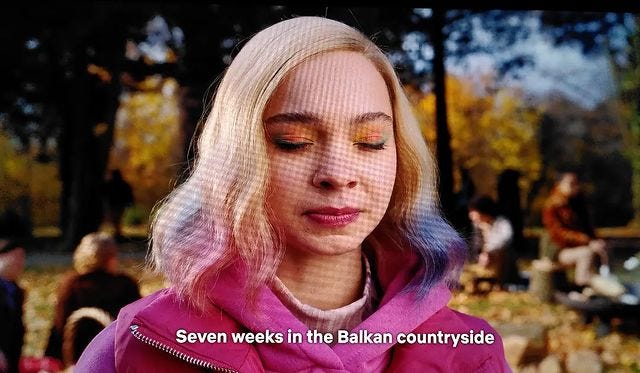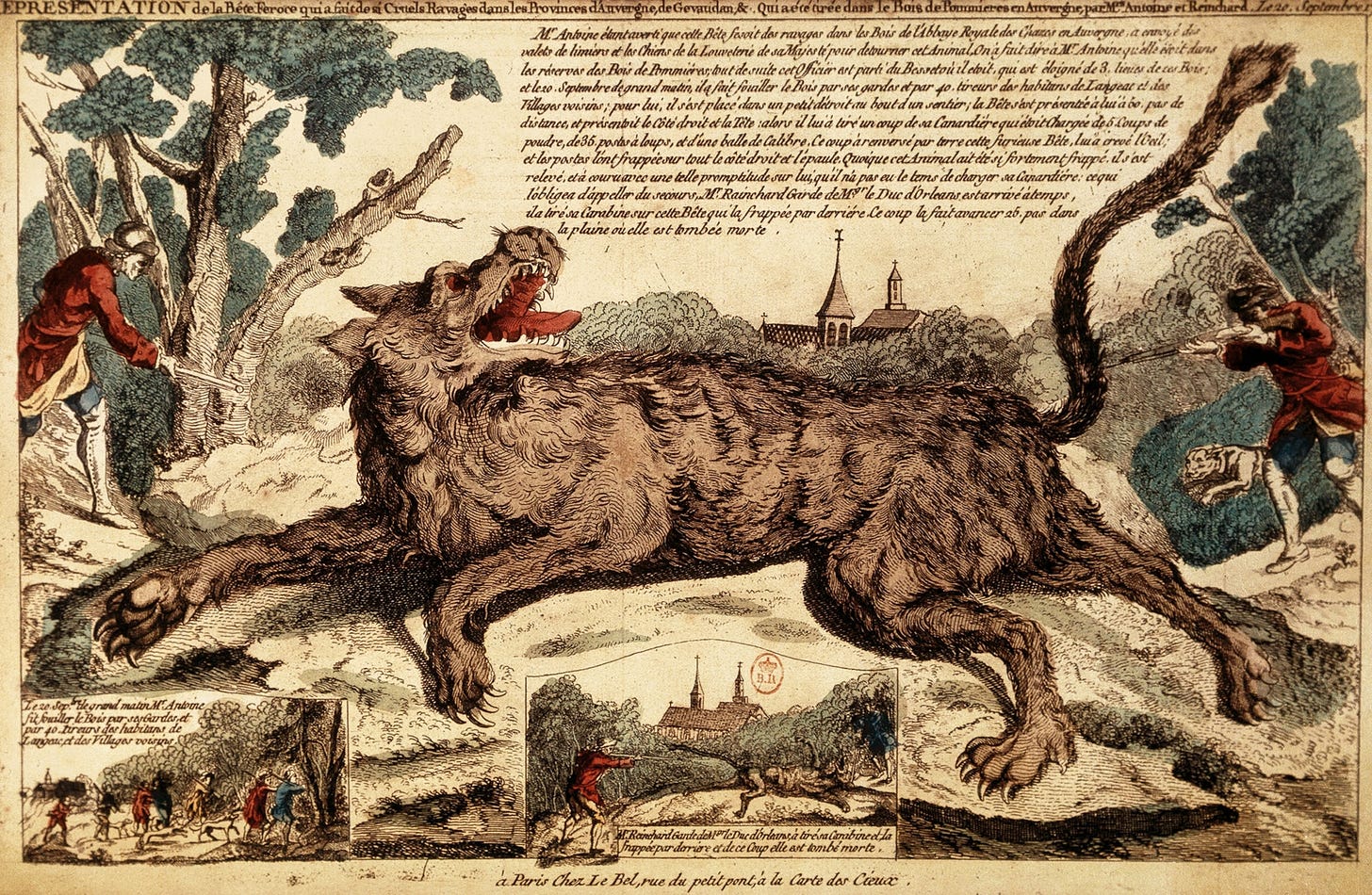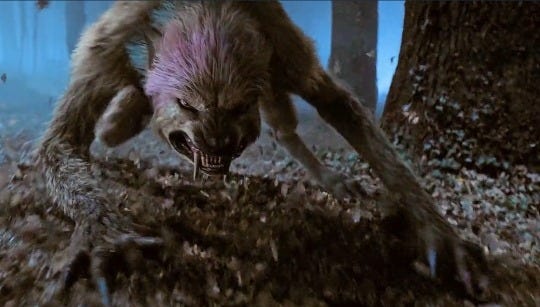S3E11. Wednesday Addams' Balkan werewolves
The character of Enid Sinclair, co-star and werewolf in the Netflix series "Wednesday", is inspired by intricate and complex supernatural creatures rooted in the ancestral South Slavic folk traditions
Hi,
welcome back to BarBalkans, the newsletter (and website) with blurred boundaries.
«Seven weeks in the Balkan countryside and you will howl at the moon in no time».
There is a werewolf in the TV series of the moment. Enid Sinclair is probably the best portrayed character in the Netflix series Wednesday, that follows the adventures of Wednesday Addams at Nevermore Academy.
Enid is an outgoing, gossipy and sunny young werewolf. As a roommate, she is Wednesday’s perfect nemesis, but she gradually becomes her best friend.
While Wednesday Addams investigates the secrets of the small town Jericho, she is finding her own way to complete her transformation into a werewolf.
But what do we know about werewolves?
And, more importantly, about the intricate folk cultures in a socially complex and culturally prolific region like the Balkans?
Because it is precisely from there that we must start our journey discovering what lies behind the character of Wednesday’ Enid Sinclair.
Precisely, supernatural creatures born from the South Slavs’ centuries-old popular imagination.
Have you checked out BarBalkans’ Instagram profile yet? Find out how werewolves and the Balkans intersected in one of the 8 episodes of the Netflix series Wednesday:
ATTENTION! This newsletter contains spoilers about the Netflix series Wednesday
“Fleece of wolf”
There is a great variety of names used to describe a werewolf, according to Croatian, Serbian, Bosnian and Montenegrin ethnographic sources.
This is highlighted in a study by Maja Pasarić on the history of werewolves in South Slavic folk traditions.
Vukodlak, but also vukozlak, volkolak, vovkulak o vlkodlak.
It is interesting to note the etymology. The term ‘werewolf’ is believed to derive from Proto-Slavic vьlk (wolf) and South Slavic dlaka (fleece).
There is some confusion on the exact meaning of vukodlak. Both because oral traditions have differed over the centuries, but also because werewolves have also often intersected to other supernatural creatures.
Werewolf narratives are widespread in South Slavic folk cultures and stems from the concept of a living being who can occasionally transform into a wolf, attacking - in this form - other humans or animals.
However, as it can be noticed in the codification of oral traditions in the 19th century, vukodlak has increasingly become a walking dead. A person who returns from the grave taking different physical characteristics, often of an animal.
At this point Balkan folk traditions differ from other European ones, standardized with the lycanthropic character of a living man. A breeding ground for more and more stratified mythologies.
If we want to outline the most common characteristics of the werewolf in South Slavic folk traditions, we have to start from the transformation of a person after death.
In some cases, the identity of a werewolf can be recognized at birth. For instance, when a baby is born in a cauldron.
The favorite moment of action for werewolves is at night, and some traditions report an extensive appearance in the winter period.
When they attack people and animals, werewolves suck the blood from their prey and, occasionally, they kill them and take them to the grave. But sometimes these supernatural creatures simply return to their families to continue their relations with their former wives.
The reasons for the reappearance of a dead person in the form of a wolf are commonly related to unfinished business with family or community members, who must provide for their redemption in order for werewolves to stop reappearing.
Magical and religious practices can be performed for protection from werewolves’ attacks, as well to avoid becoming one. But the ultimate way to defeat these creatures is to pierce their body or their heart, usually with a hawthorn stick.
Werewolves and vampires
In South Slavic folklore, all these cultural forms intersect with the concepts of death and afterlife, with the transformation of the human body and with animal symbolism.
This is how narratives about werewolves overcome the differences between supernatural creatures and open up new fantastic worlds.
In the Balkan region, the history of werewolves merges with beliefs about vampires. To the point that in Serbia the term vukodlak can define both creatures.
Werewolves and vampires have several similarities: both suck the blood of their preys, they are closely linked to the lunar cycle and the full moon, in human form they are pale, with emaciated faces, hollow orbs and swollen lips.
But most of all, they share the characteristic of being “bridge creatures”.
The werewolf is a bridge between the human and the animal world. The vampire is a bridge between the living and the dead world.
The difference is so subtle that it blurs and, very ofetn, is embodied in a single supernatural being. Vukodlak.
While the lycanthrope’s characteristics can be traced back to antiquity and Medieval traditions, it seems plausible that the late Middle Ages was the time when the fate of werewolves and vampires intertwined among South Slavs.
Records of South Slavic beliefs dating back to the 15th and 16th centuries talk about souls who died under the curse of a werewolf and that were destined to return to the world of the living as vampires.
Between the 18th and the beginning of the 20th century in Eastern Montenegro and Central-Western Serbia, the accounts report of a certain period of time when every vampire took on the form of a wolf.
The etymological syncretism between vampires and werewolves reaches recent times. In the Dictionary of Serbo-Croatian Language (1971-1972) of the Yugoslav Academy of Sciences and Arts, the concept of vampire is linked to the concept of werewolf under the term Vukodlak.
A human being who returns to the world of the living after death, with the characteristics of an animal. Preferably, a wolf.
Pit stop. Sittin’ at the BarBalkans
We have reached the end of this piece of road.
Today, on our bar, the BarBalkans, we find a Bloody Mary.
Although it is certainly not a Balkan cocktail, we could not wish for anything more appropriate with werewolves and the TV series that inspired this newsletter.
First of all, because the red of the tomato juice that gives Bloody Mary its unmistakable color can be a reference to the blood of werewolf victims.
But mostly because Bloody Mary is the title of Lady Gaga’s song that got famous again thanks to Wednesday.
Or rather, thanks to the fans of the Netflix series who recreated one of the most iconic scenes on TikTok. The scene where Wednesday Addams dances in a very… Wednesday Addams way.
The choreography that has become extremely popular on social media is based on Lady Gaga’s Bloody Mary, even if the song is not included in the series’ soundtrack (the original scene is based on The Cramps’ Goo Goo Muck).
To further cross-reference this series with the spirit of our newsletter, other fans have created a version of Wednesday’s Bloody Mary with an all-Balkan sound:
Let’s continue the BarBalkans journey. We will meet again in two weeks, for the 12th stop.
A big hug and have a good journey!
Your support is essential to realize all that you have read. And even more.
Because a job well done - always aiming to improve - needs many hours and energy, also to keep BarBalkans newsletter free for everyone.
An independent project like this cannot survive without the support of the readers. For this reason I kindly ask you to consider the possibility of donating:
Every second Wednesday of the month you will receive a monthly article-podcast on the Yugoslav Wars, to find out what was happening in the Balkans - right in that month - 30 years ago.
You can listen to the preview of BarBalkans - Podcast on Spreaker and Spotify.
Pay attention! The first time you will receive the newsletter, it may go to spam, or to “Promotions Tab”, if you use Gmail. Just move it to “Inbox” and, on the top of the e-mail, flag the specific option to receive the next ones there.










